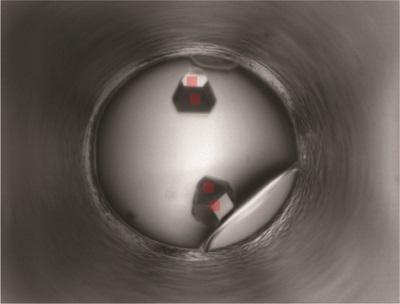Screen to beam technology: The rise of haptic interfaces

The interface displays minimal features to improve usability. Credit: Bruno et al.
The haptic interface provides the immediate “front end”. An equally powerful and parallel development has been cloud computing technology, where information and processing power can be shared between multiple users. The combination of these two technologies can provide both ease of use in information analysis and a wide area of application in sharing and making use of the analysis.
Point and click interfaces are common in many forms of instrumentation. An image is displayed and a human operator interprets that image, together with any associated data, feeding back results with the motion and click of a mouse and sometimes keyboard data entry.
In the field of X-ray crystallography, the initial images that need to be interpreted are typically experiments aimed at the crystallisation of biological macromolecules. Each is viewed and classified in order to guide and optimise crystallisation efforts.
If success occurs in the crystallisation step, another application of imaging occurs and the images of mounted crystals are used to position them appropriately with respect to the X-ray beam for diffraction analysis. For limited studies, point and click interfaces are convenient, but as the number of images involved begin to increase, even these user-friendly interfaces can become burdensome.
At the Hauptman-Woodward Medical Research Institute, the High-Throughput Crystallisation Screening Centre provides a crystallisation screening service sampling 1536 different chemical conditions. If a potential crystal is identified, the laboratory providing the sample then conducts optimisation experiments centred around the screening results. Once optimised, the resulting crystals are used for diffraction studies.
In a recent paper, scientists from Hauptman-Woodward, Diamond Light Source and Universities in the US [Bruno et al. (2016), J. Appl. Cryst. 49, doi:10.1107/S160057671601431X study the crystallisation outcome and how it is linked to the subsequent diffraction analysis, with the aim of facilitating or potentially eliminating an initial optimisation step. Their study focuses attention on the value and importance of the user interface and process.
Embracing a haptic interface to enable the visualisation, classification and notation of experimental crystallisation data with a cloud-based database of images allows multiple collaborators to share the information and to fill the missing link between screening and diffraction characterisation.
Information is passed directly to the beamline so that the crystallization screening plate can be analysed in the beam efficiently. This work broadly demonstrates the power of haptic interfaces and web computing to create a shareable scientific environment in crystallography and beyond.
Media Contact
All latest news from the category: Life Sciences and Chemistry
Articles and reports from the Life Sciences and chemistry area deal with applied and basic research into modern biology, chemistry and human medicine.
Valuable information can be found on a range of life sciences fields including bacteriology, biochemistry, bionics, bioinformatics, biophysics, biotechnology, genetics, geobotany, human biology, marine biology, microbiology, molecular biology, cellular biology, zoology, bioinorganic chemistry, microchemistry and environmental chemistry.
Newest articles

High-energy-density aqueous battery based on halogen multi-electron transfer
Traditional non-aqueous lithium-ion batteries have a high energy density, but their safety is compromised due to the flammable organic electrolytes they utilize. Aqueous batteries use water as the solvent for…

First-ever combined heart pump and pig kidney transplant
…gives new hope to patient with terminal illness. Surgeons at NYU Langone Health performed the first-ever combined mechanical heart pump and gene-edited pig kidney transplant surgery in a 54-year-old woman…

Biophysics: Testing how well biomarkers work
LMU researchers have developed a method to determine how reliably target proteins can be labeled using super-resolution fluorescence microscopy. Modern microscopy techniques make it possible to examine the inner workings…





















